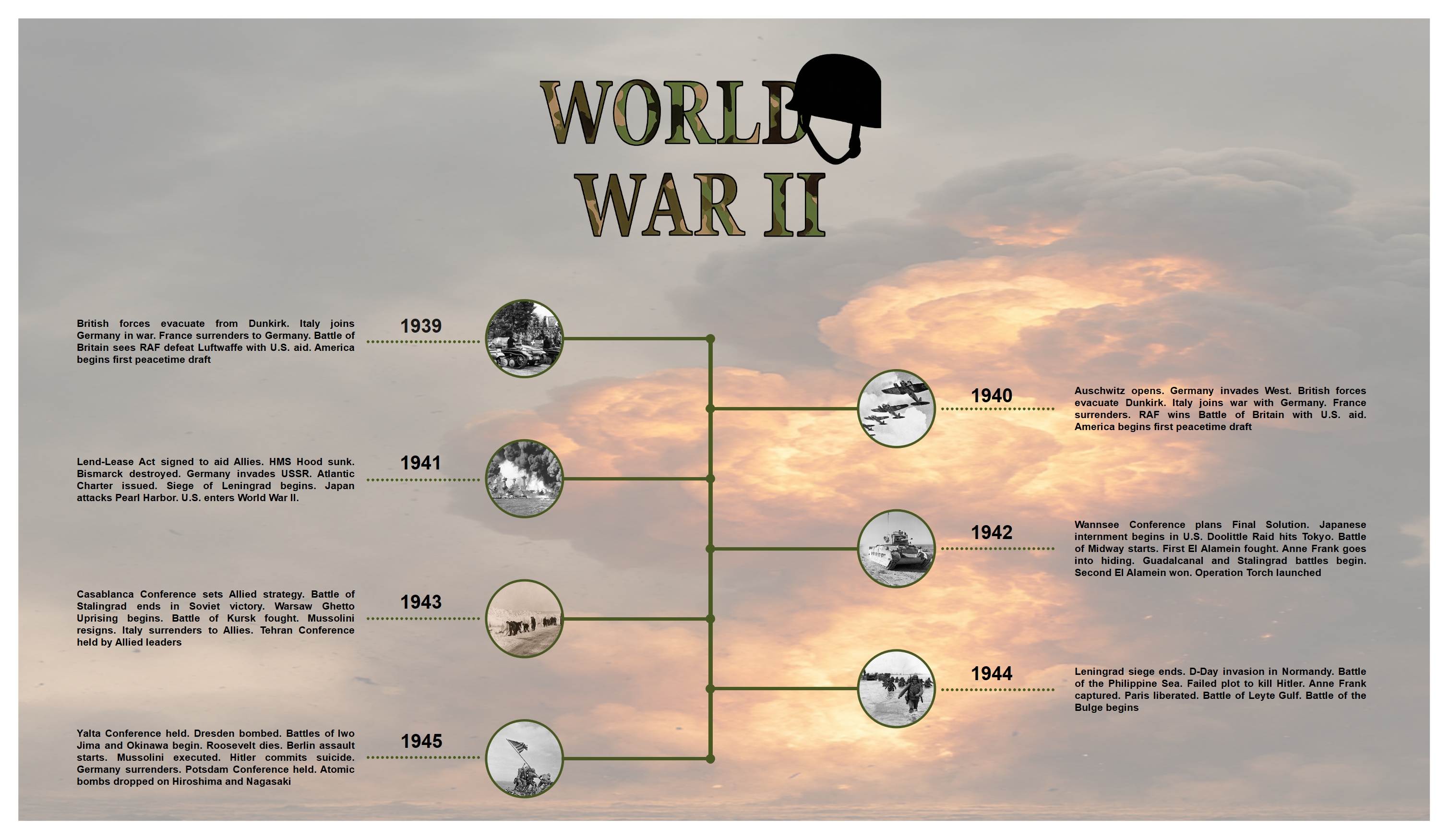The injustices carried out by the victors of the First World War led to another significant yet bloodiest chapter in modern-day political history. The Second World War started with more than fifty states and ended with the complete annihilation of two cities in Japan. The atomic bomb has ever since dominated nations' interactions in the system.
Learn all about the horrors of this episode with the World War II timeline, how it was triggered, what led to the atomic bombing of Japan, and more.
The injustices carried out by the Second World War started with more than fifty states and ended with the complete annihilation of two cities in Japan. The atomic bomb has ever since dominated nations' interactions in the system.
Learn all about the horrors of this episode with the World War II timeline, how it was triggered, what led to the atomic bombing of Japan, and more.
In this article
World War II Timeline: Major Events Explained
1939
Rising tensions in Europe with Hitler’s dominance and the Japanese invasion of China triggered the initial events of World War II. The war officially began with Hitler's invasion of Poland.
On August 23, the USSR and Germany allied with the Non-Aggression Pact. This pact would later ensure the Soviets’ military assistance to Hitler.
Hitler invaded Poland on September 1, officially declaring war against the Allies.
On September 3, Britain and France entered the war in response to this declaration.
Late September saw the Battle of the Atlantic between London and Berlin. On the Eastern Front, Russians were already engaged with Polish forces. With Poland conquered, the government took refuge in Poland.
1940
The security dilemma continued in Europe. The consecutive conquests of Germany created rising insecurity among Allied powers. Subsequently, the US abandoned its policy of neutrality and joined the Allied bloc.
Hitler established the Auschwitz Nazy camps in early May.
On May 10, he began to invade Belgium and France. Before this, Germany had already invaded and conquered Denmark and Norway, ending the six-month phony wars.
Late May and early June began with the Dunkirk Operation. During this time, the trapped British forces evacuated to England. Meanwhile, Italy waged a war against Britain and France by allying with Germany through the Pact of Steel.
On July 10, Britain, following France's surrender, initiated the Battle of Britain and defeated the Luftwaffe, or German Air Force.
America started drafting its first peacetime proposal on September 16.
1941
The power dynamics remained turbulent during 1941. Germany broke its pact and turned against the USSR, which joined the Allied bloc. Japan carried out an attack against the US in the Pacific.
On March 11, Franklin Roosevelt of the US signed the Lend-Lease bill proposed by the UK.
In April, the European states, concerned for their survival, joined the Axis and invaded Yugoslavia. Yugoslavia surrendered on April 17.
In May, history repeated itself, and the German battleship Bismarck sank the British HMS Hood. However, following the huge embarrassment, the Royal Navy torpedoed Bismarck three days later.
June started with Germany invading Russia and advancing 200 miles into Moscow. It was called Operation Barbarossa.
As tensions rose, the two leaders, Roosevelt and Churchill, met for the Atlantic Conference to propose a joint declaration in August.
On September 8, the Axis powers further advanced into Leningrad, USSR, seizing the territory.
The Pearl Harbor episode began on December 7. Around 360 Japanese aircraft attacked the Pearl Harbor naval base in Hawaii, compelling Congress to declare war on Japan.
1942
Though 1942 started with Japan being dominant, the Battle of Midway changed the power dynamics. By mid-1942, the Allies were already at an advantage in the Pacific and Africa.
The Allied powers, concerned with the fate of jews in Europe, held the Wannsee Conference on January 20.
On February 19, President Roosevelt issued Executive Order 9066, calling for the internment of Japanese Americans.
Following this, the US launched air raids by the name of Doolittle on major cities of Japan in April.
As the animosity between the US and Japan deepened, the US Navy waged the Battle of Midway and claimed victory after taking down Japanese aircraft carriers.
In July, the Axis and Allied forces had a lengthy face-off in Egypt, known as the Battle of El Alamein. Moreover, Anne Frank, the German-Jewish girl, also went into hiding this month.
The following month, several naval and land battles began, marking the start of the Guadalcanal campaign. The Battle of Stalingrad between the Axis powers and the USSR, for control of the city, also started during this time.
On October 23, Italy and Germany suffered a massive defeat in the second Battle of El Alamein.
Americans launched Operation Torch in Africa in November to aid the British forces. The operation ended with France losing its territories in Algeria and Morocco.
1943
1943 remained in favor of Allied power; the USSR gained significant victories against Germany, Italy surrendered, and the US remained dominant in the Pacific.
The extension of the Wannsee conference, the Casablanca Conference, was held by the Allies on January 14 to finalize a strategy plan against the Axis.
On February 2, the Germans surrendered in Stalingrad.
On April 19, Jewish revolutionaries started the Warsaw Ghetto uprising in occupied Poland.
During July, Hitler and Lenin's forces fought the Battle of Kursk, with the USSR claiming victory. Meanwhile, in Italy, the Fascists overthrew Mussolini and established a new government under Pietro Badoglio.
Italy surrendered to the Allies under the newly established government, leaving the northern territories to Germany.
In November, the Allies once again met at the Tehran Conference to initiate a strategy.
1944
In 1944, the war was mostly fought in Eastern Europe. Allies gained victory in most battles during the year. These battles also set the stage for Hitler’s defeat and Germany’s exit from the war.
1944 began with the end of the siege of Leningrad on January 27.
D-Day began on 6 June, when the Allied forces advanced into Normandy, France, to liberate it. In the following days, the US won the Battle of the Philippines against Japan.
It was during July that the assassination attempt against Hitler, known as the 20 July Plot, failed.
In August, Anne Frank was arrested, and the Allied forces liberated Paris.
Germany launched the Battle of the Bulge on December 16 to push the Allied forces out of the territories. It was Hitler’s last battle before Germany surrendered.
1945
After gaining an obvious victory on the European front, the Allies continued fighting Japan in the Pacific during 1945. The war ended officially with the US dropping atomic bombs.
February saw consecutive Allied wins over the Axis, starting with the bombing of the German city of Dresden. Moreover, the US captured Japanese islands from the Imperialist Army. This event today is known as the Battle of Iwo Jima.
On April 1, the Battle of Okinawa began between the US and the Imperial Army in the Pacific. During the battle, President Roosevelt died of declining health. Four days later, the USSR blocked Berlin. Moreover, on April 28, the Italian revolutionaries assassinated Mussolini. Two days later, Hitler committed suicide, leading Germany to surrender unconditionally.
The Potsdam Conference began on July 17. The Allied leaders discussed the war with Japan and divided Germany into four occupational zones.
August 1945 saw the worst of World War II. Considering Japan’s resistance, the US dropped the first atomic bomb, Little Boy, on Hiroshima. Three days later, the Americans dropped another bomb called Fat Man on Nagasaki.
In September, Japan surrendered to US General Douglas, officially ending the Second World War.
How to Make a Similar Timeline using EdrawMax?
Capturing a lengthy period with overlapping events can be a challenge. But you can find the solution in timelines. These infographics depict an easily understandable sequence of events. Thankfully, timeline tools like EdrawMax further simplify it for beginners with no design skills. Its massive symbol library and intuitive UI take minutes to replicate a timeline.
Wondering how it goes? Here is a complete tutorial on how you can replicate a similar World War II timeline using this software.
Step1Open the Blank Canvas
Before you begin, download and install the EdrawMax desktop version and log in to your account.
- Visit the Home tab from the dashboard and click Basic Diagram > Timeline from the on-screen menu.
- Choose a desired blank canvas from below to enter the canvas.
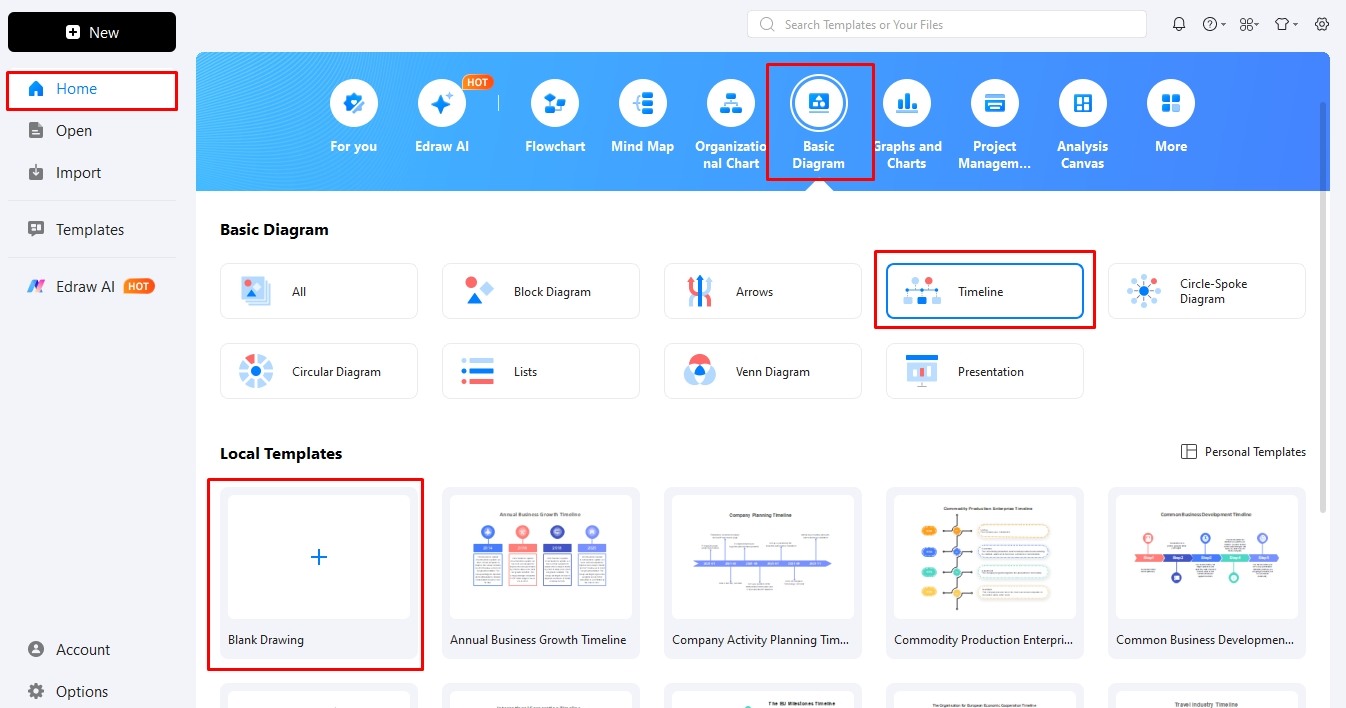
Step2Plot the Structure
First, plot the structure of your time, as it will determine all other elements, be it content or visual cues. Take your time thinking about what layout best suits your data.
- Once decided, locate the Symbol library from the left side of the canvas.
- Under the Timeline section, find a suitable layout, be it horizontal or vertical.
- Drag this layout onto the canvas.
- Wait, you are not done. Personalizing this layout is always a good idea, as it lets you incorporate color elements that will be helpful later on, such as event count, colors, etc.
So, select the structure and modify it.
- Number of milestones: Adjust how many events are in your timeline. For instance, the World War II timeline has six events.
- Milestone size: Decide whether you want milestones to be of small, medium, or large size.
- Timeline type: Choose between a vertical and horizontal sequencing of events.
- Line: Modify the line direction and flow accordingly.
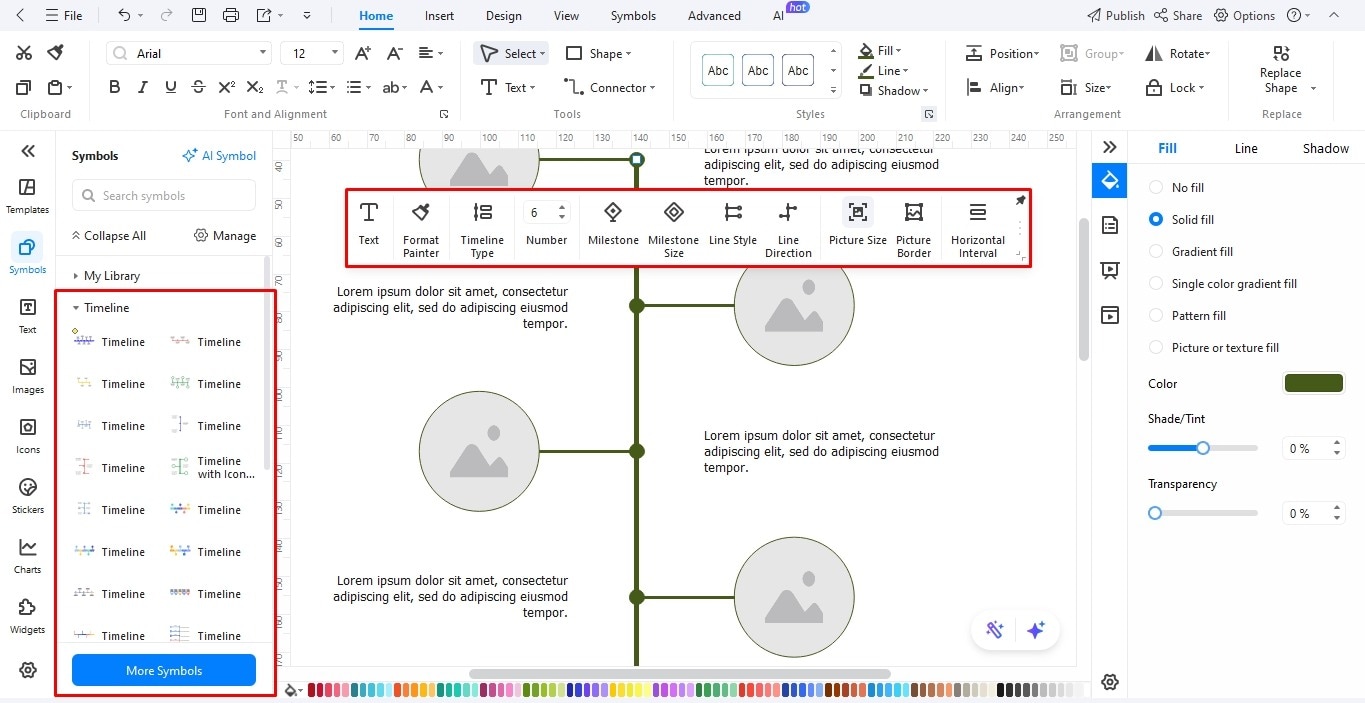
Step3Add Text Labels
Satisfied with the layout? If yes, let’s go and fill it with the content. For this,
- Double-click anywhere on the canvas and start writing.
- Do not make the labels wordy. A one-line description is more than enough.
- Use the on-screen menu to change the style, color, and size of the font.
- Struggling with the lengthy description? Use Edraw AI. It uses advanced algorithms to shorten the text, translate it, modify it, or even summarize it.
- For this, select the text you want to summarize and click Edraw AI from the menu.
- Choose Polish Text, Shorten the Text, etc, and leave the rest to the software.
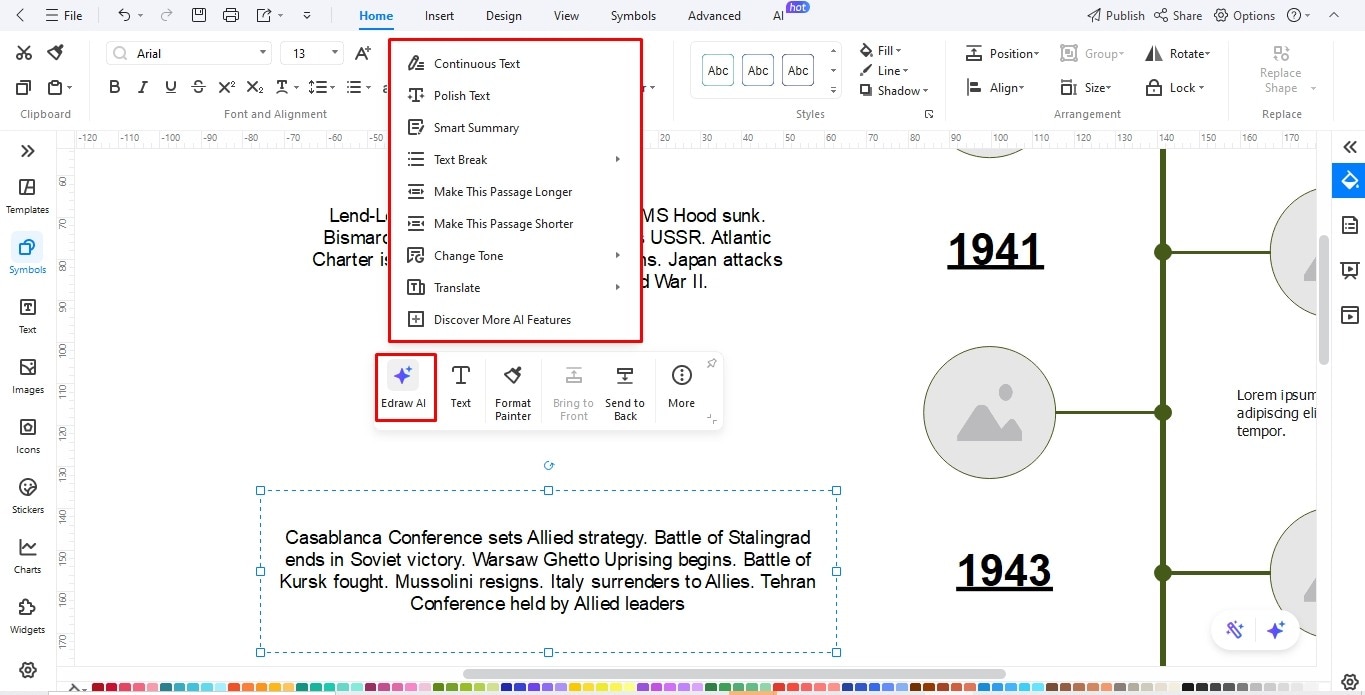
Step4Insert Pictures
Technically, your timeline is complete. But it can do better with pictures. They are an excellent way to gauge your audience, as most people have a photographic memory. For this,
- Visit the Insert tab from the top and click Picture.
- Once on the canvas, change its frame size, shape, and picture’s transparency, contrast, etc.
- Alternatively, use the Image libraries from the left side to find suitable pictures for your diagram.
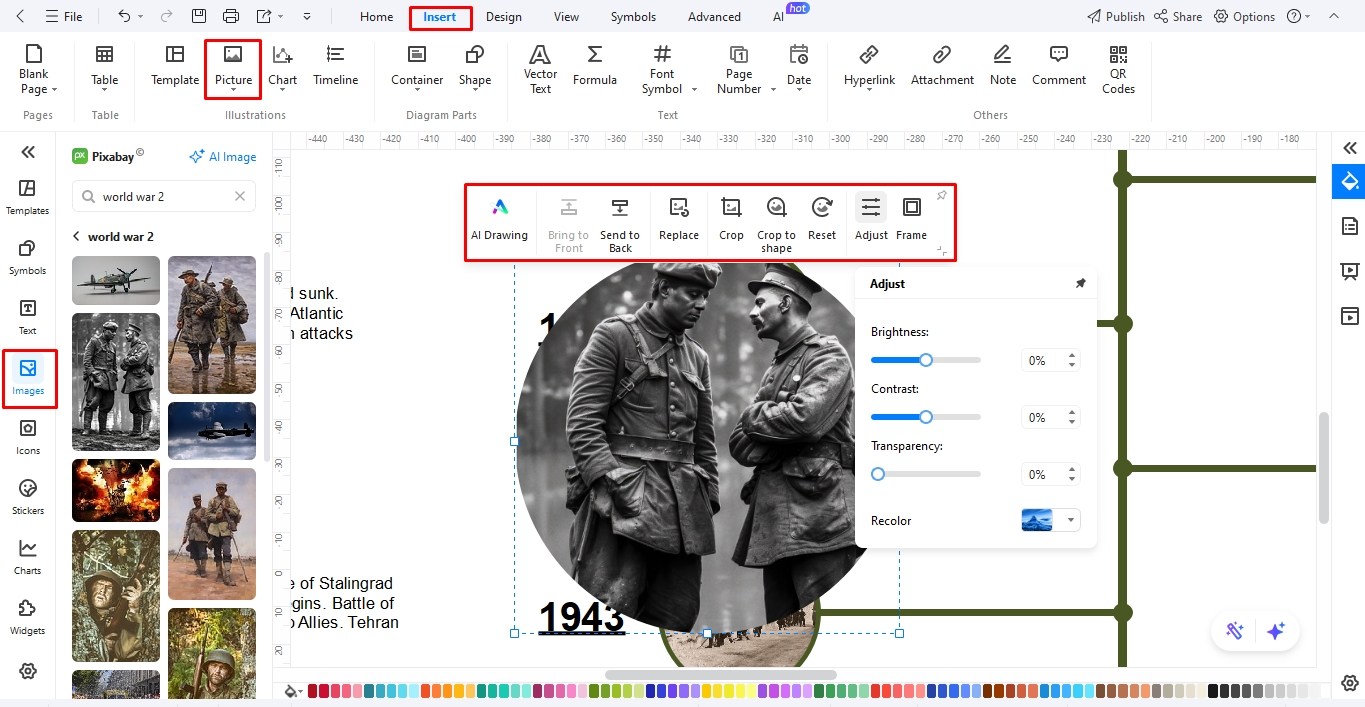
Step5Customize the Theme
Hold on, just a little left. All you need to do is modify the design details. For this,
- Go to the Design tab at the top.
- Change the color scheme, background image, and theme of the diagram.
- You can also set your desired colors in a personalized theme for later use.
- Alternatively, use any image from the existing library for the diagram background.
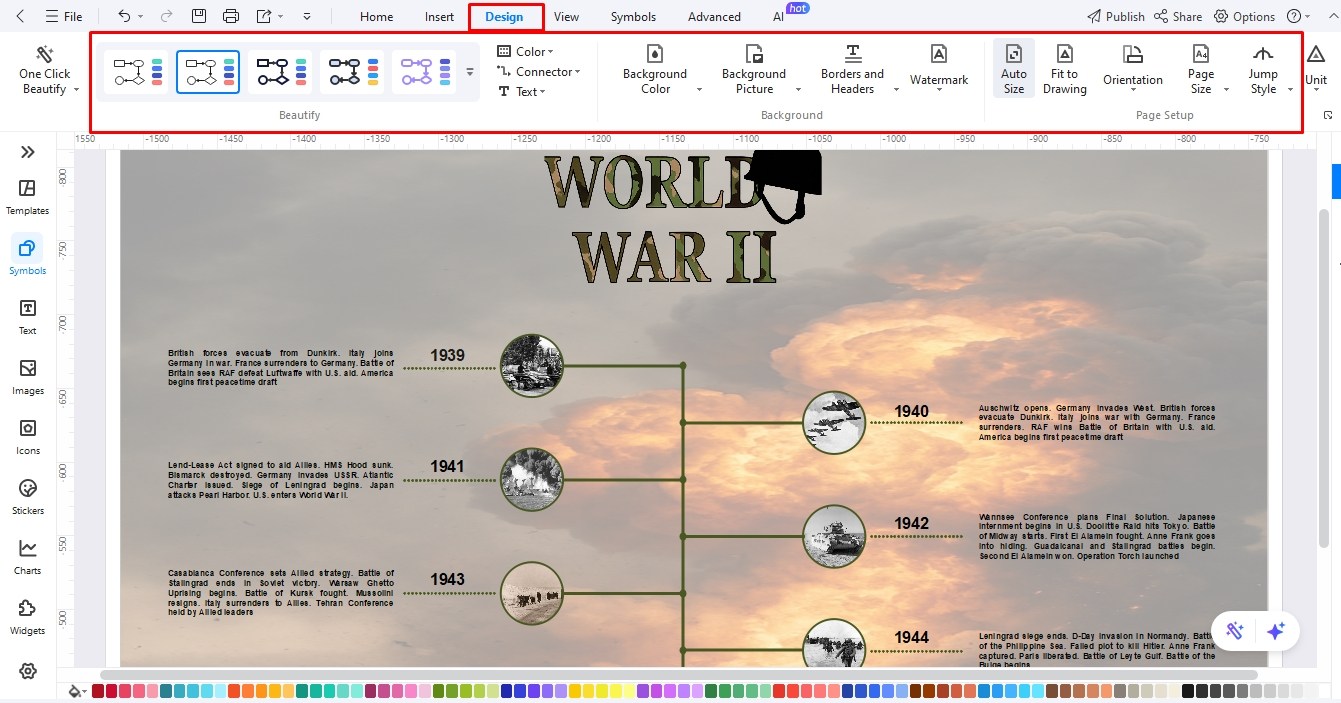
Step6Download and Share!
Congratulations, your timeline infographic is all set to be downloaded or shared. For this,
- Locate the Export icon from the quick-access toolbar and choose your preferred format (PNG, JPG, Visio, PDF, etc).
- Or, click Share from the quick-access, edit permission (who can view, edit, etc), and share the system-generated link with people you desire.
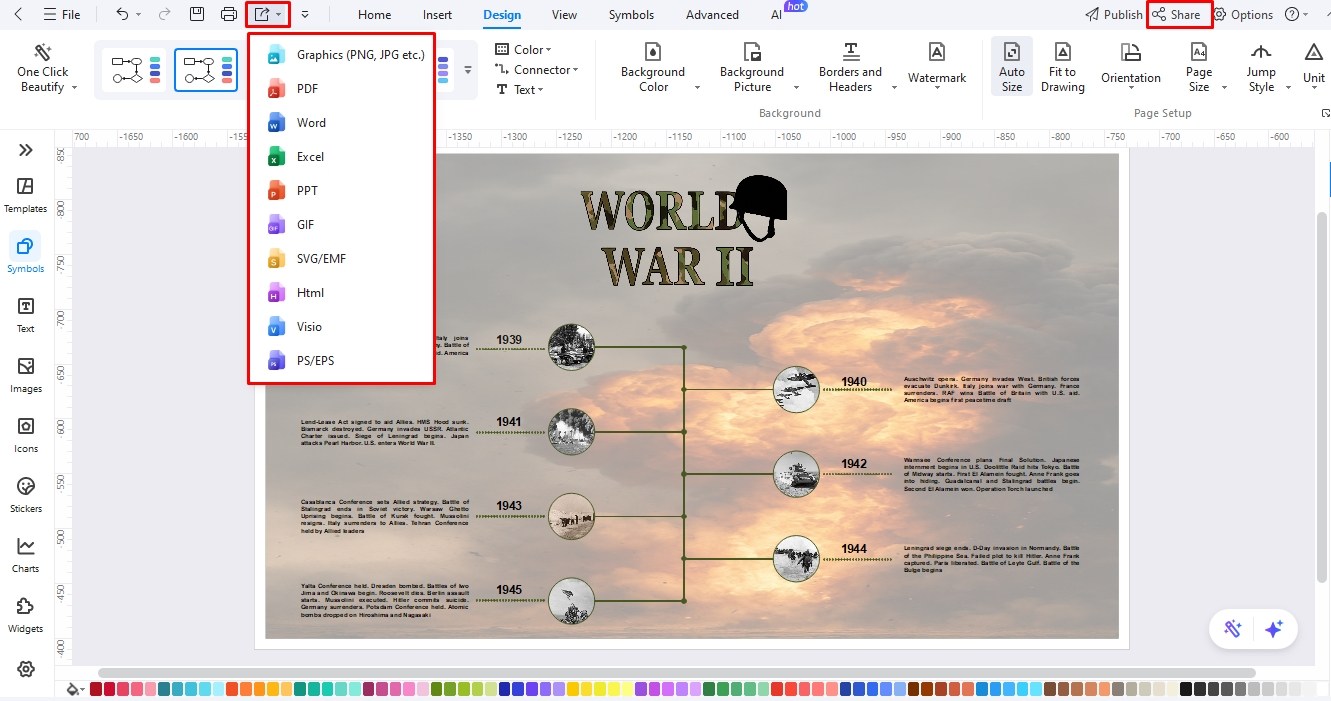
Final Thoughts
The World War II timeline intricately captures how the events escalated throughout the six years and snowballed into a violent global phenomenon. It is not only about who did what, but rather, the understanding of how miscalculations and fascist agendas guided the actions of leaders.
You can create a similar infographic using EdrawMax in minutes. Head over to its template community to explore more similar historical timelines.



